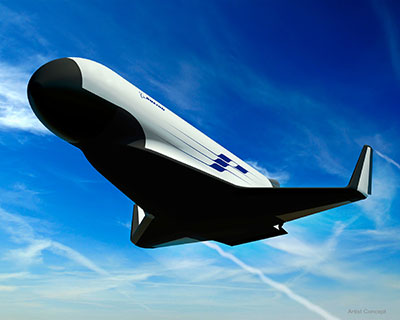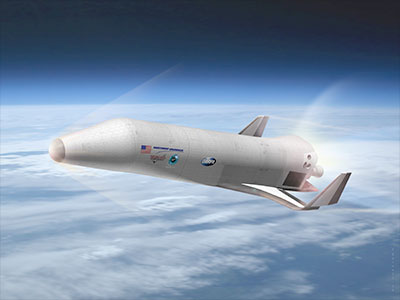|
|

|
 |
| Forum: | Commercial Space - Military Space |
| Topic: | DARPA XS-1 Experimental Spaceplane (Phase 1) |
|
| Want to register?
|
If you have previously registered, but forgotten your password, click here.
DARPA created its Experimental Spaceplane (XS-1) program to help overcome these challenges and create a new paradigm for more routine, responsive and affordable space operations. In an important step toward that goal, DARPA has awarded prime contracts for Phase 1 of XS-1 to three companies: - The Boeing Company (working with Blue Origin, LLC)
- Masten Space Systems (working with XCOR Aerospace)
- Northrop Grumman Corporation (working with Virgin Galactic)
"We chose performers who could prudently integrate existing and up-and-coming technologies and operations, while making XS-1 as reliable, easy-to-use and cost-effective as possible," Jess Sponable, DARPA program manager. "We're eager to see how their initial designs envision making spaceflight commonplace—with all the potential military, civilian and commercial benefits that capability would provide."The XS-1 program aims to develop a fully-reusable unmanned vehicle that would provide aircraft-like access to space and deploy small satellites to orbit using expendable upper stages. XS-1 seeks to deploy small satellites faster and more affordably, and develop technology for next-generation hypersonic vehicles. XS-1 envisions that a reusable first stage would fly to hypersonic speeds at a suborbital altitude. At that point, one or more expendable upper stages would separate and deploy a satellite into Low Earth Orbit (LEO). The reusable first stage would then return to earth, land and be prepared for the next flight. Modular components, durable thermal protection systems and automatic launch, flight and recovery systems should significantly reduce logistical needs, enabling rapid turnaround between flights. Key XS-1 technical goals include flying 10 times in 10 days, flying to Mach 10+ at least once and launching a representative small payload to orbit. The program also seeks to reduce the cost of access to space for 3,000- to 5,000-pound payloads to less than $5 million per flight. In Phase 1 of XS-1, DARPA intends to evaluate the technical feasibility and methods for achieving the program's goals. Tasks currently include: - Develop the XS-1 demonstration vehicle
- Identify and conduct critical risk reduction of core component technologies and processes
- Develop a technology maturation plan for fabrication and flight test of XS-1 system capabilities
DARPA expects the performers to explore alternative technical approaches from the perspectives of feasibility, performance, system design and development cost and operational cost. They must also assess potential suitability for near-term transition opportunities to military, civil and commercial users. These opportunities include both launching small payloads per the program goals as well as others, such as supporting future hypersonic testing and a future space access aircraft. | | Robert Pearlman | Boeing release Boeing to Design XS-1 Experimental SpaceplaneDARPA program seeks to lower satellite launch costs Boeing plans to design a reusable launch vehicle for the Defense Advanced Research Projects Agency (DARPA) in support of the U.S. government's efforts to reduce satellite launch costs. DARPA's XS-1 Experimental Spaceplane is conceived as a reusable, unmanned booster with costs, operation and reliability similar to modern aircraft. "Developing a vehicle that launches small payloads more affordably is a priority for future U.S. Defense Department operations," said Steve Johnston, director of Boeing's Phantom Works Advanced Space Exploration division. "Boeing brings a combination of proven experience in developing launch systems and reusable space vehicles, along with unparalleled expertise in the development and fielding of highly operable and cost-effective transportation systems."  Under the $4 million preliminary design contract, Boeing plans to work on a reusable first stage launch vehicle capable of carrying and deploying an upper stage to launch small satellite payloads of 3,000 to 5,000 pounds (1,361 kg to 2,268 kg) into low-Earth orbit. "Our design would allow the autonomous booster to carry the second stage and payload to high altitude and deploy them into space. The booster would then return to Earth, where it could be quickly prepared for the next flight by applying operation and maintenance principles similar to modern aircraft." said Will Hampton, Boeing XS-1 program manager. "Drawing on our other innovative technologies, Boeing intends to provide a concept that uses efficient, streamlined ground infrastructure and improves the turnaround time to relaunch this spacecraft for subsequent missions." DARPA plans to hold a Phase II competition next year for the follow-on production order to build the vehicle and conduct demonstration flights. | | Robert Pearlman | Northrop Grumman release Northrop Grumman Developing XS-1 Experimental Spaceplane Design for DARPANorthrop Grumman Corporation with Scaled Composites and Virgin Galactic is developing a preliminary design and flight demonstration plan for the Defense Advanced Research Projects Agency's (DARPA) Experimental Spaceplane XS-1 program. XS-1 has a reusable booster that when coupled with an expendable upper stage provides affordable, available and responsive space lift for 3,000-pound class spacecraft into low Earth orbit. Reusable boosters with aircraft-like operations provide a breakthrough in space lift costs for this payload class, enabling new generations of lower cost, innovative and more resilient spacecraft.  The company is defining its concept for XS-1 under a 13-month, phase one contract valued at $3.9 million. In addition to low-cost launch, the XS-1 would serve as a test-bed for a new generation of hypersonic aircraft. A key program goal is to fly 10 times in 10 days using a minimal ground crew and infrastructure. Reusable aircraft-like operations would help reduce military and commercial light spacecraft launch costs by a factor of 10 from current launch costs in this payload class. To complement its aircraft, spacecraft and autonomous systems capabilities, Northrop Grumman has teamed with Scaled Composites of Mojave, which will lead fabrication and assembly, and Virgin Galactic, the privately-funded spaceline, which will head commercial spaceplane operations and transition. "Our team is uniquely qualified to meet DARPA's XS-1 operational system goals, having built and transitioned many developmental systems to operational use, including our current work on the world's only commercial spaceline, Virgin Galactic's SpaceShipTwo," said Doug Young, vice president, missile defense and advanced missions, Northrop Grumman Aerospace Systems. "We plan to bundle proven technologies into our concept that we developed during related projects for DARPA, NASA and the U.S. Air Force Research Laboratory, giving the government maximum return on those investments," Young added. The design would be built around operability and affordability, emphasizing aircraft-like operations including: - Clean pad launch using a transporter erector launcher, minimal infrastructure and ground crew;
- Highly autonomous flight operations that leverage Northrop Grumman's unmanned aircraft systems experience; and
- Aircraft-like horizontal landing and recovery on standard runways.
Northrop Grumman is a leading global security company providing innovative systems, products and solutions in air and space unmanned systems, cyber, C4ISR, and logistics and modernization to government and commercial customers worldwide. | |



